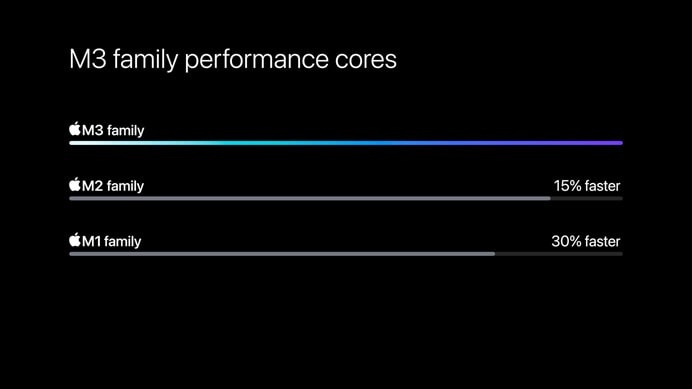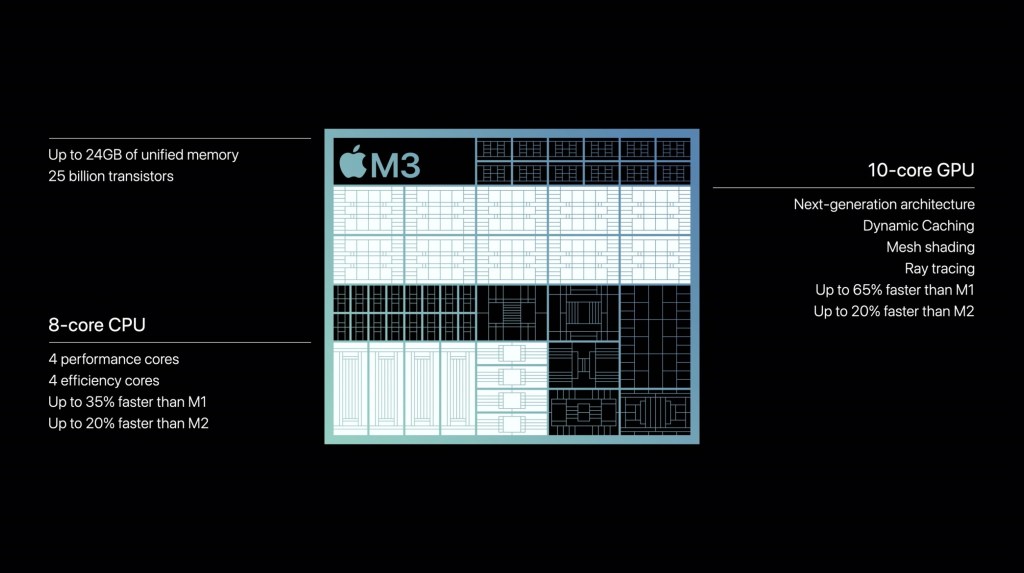Apple finally announced the new family of M3 chips at the “Scary Fast” event on Halloween Eve. After the unveiling of Snapdragon X Elite, a direct competition to Apple’s M-series silicon, Apple has been quick to respond to the market. But is the Apple M3 a breakthrough chipset and does it bring a meaningful upgrade over the Apple M2?
In this article, we have compared the Apple M3 vs M2 with regards to CPU, GPU, memory bandwidth, neural engine, and more. So let’s not waste time and check out the performance difference between Apple M3 and Apple M2.
Apple M3 vs M2: Specs Comparison
| Apple M3 | Apple M2 | |
|---|---|---|
| Fabrication Process | TSMC’s 3nm | TSMC’s 5nm |
| Transistors | 25 Billion (M3) 37 Billion (M3 Pro) 92 billion (M3 Max) | 20 Billion (M2) 40 Billion (M2 Pro) 67 Billion (M2 Max) 134 Billion (M2 Ultra) |
| CPU Cores | Up to 8, 12, and 16 cores | Up to 8, 12, 12, and 24 cores |
| GPU Cores | Up to 10, 18 and 40 cores | Up to 10, 19, 38, and 76 cores |
| Frequency (Max) | Up to 3.8GHz (likely) | 3.49GHz to 3.7GHz |
| TDP | Not known yet | 23W to 60W |
| Neural Engine | Up to 16 cores (Enhanced, 15% faster) | Up to 16 and 32 cores; 15.8 TOPS and 31.6 TOPS |
| Unified Memory (RAM) | Up to 24GB, 36GB, and 128GB | Up to 24GB, 32GB, 96GB, and 192GB |
| Memory Bandwidth | 100GBps (M3) 150GBps (M3 Pro) 300 GBps (14-core CPU M3 Max) 400 GBps (16-core CPU M3 Max) | 100GBps (M2) 200GBps (M2 Pro) 400GBps (M2 Max) 800GBps (M2 Ultra) |
| Up to 10, 18, and 40 cores | LPDDR5 (likely) | LPDDR5 |
CPU: Is 3nm Better?
Starting with the CPU first, the Apple M3 has seen architectural improvements this year and is built on TSMC’s 3nm process node, just like the Apple A17 Pro. As a result, the base Apple M3 chipset packs around 25 billion transistors, the M3 Pro has 37 billion transistors, and the M3 Max includes 92 billion transistors.
Furthermore, Apple has included 8 CPU cores on the base M3 chip, 11 or 12 CPU cores on the M3 Pro, and the M3 Max has an option of up to 14 or 16 CPU cores.

The Apple M3 family of chips also brings newer high-performance and efficient cores. According to Apple, the high-performance core on the new M3 chipset is 15% faster than M2’s high-performance core. And the efficiency core on Apple M3 is 30% faster than M2’s efficiency cores. However, Apple has restructured the CPU cluster and has reduced the number of performance cores in M3 Pro.
Unlike on Apple M2 Pro, which had 8 high-performance cores and 4 efficiency cores (8P+4E), the new M3 Pro has an equal sharing with 6P+6E cores.

The base M3 chip with 8 CPU cores has a 4P+4E cluster design, and the M3 Max with 16 cores has a 12P+4E cluster design. Consequently, in multi-threaded workloads, the Apple M3 is not a big upgrade over the M2. During the presentation, Apple mostly compared the M3 with its three-year-old M1 chipset and didn’t showcase the M3’s prowess over the M2.
Last year during the launch of M2, Apple said that M2 is 18% faster than M1. And now, Apple says M3 can deliver 35% better performance than M1 at peak power which means that M3’s CPU is about 17% better than M2. During the presentation, Apple concluded that the 8-core CPU on M3 is up to 20% faster than M2.
Well, it all depends on which M3 variant you choose and what kind of core cluster design it features. The CPU performance can be skewed heavily based on the cluster design. Overall, I would say, the CPU upgrade on the Apple M3 has been decent at best over the M2. However, if you are coming from M1, the Apple M3 is a definite upgrade.
GPU Improvements
GPU has been a major focus this year on the Apple M3. It has been developed on a next-generation architecture and supports many pro-level features. The Apple M3 starts with a 10-core GPU and goes all the way up to 40 GPU cores on the M3 Max. The M3 comes with 10 GPU cores, the M3 Pro packs in 14 and 18 GPU cores, and the M3 Max features 30 and 40 GPU cores.
It supports features such as hardware accelerated Ray Tracing for an unparalleled gaming experience with impressive lighting and a powerful reflection system. The Apple M3 GPU also supports HW-accelerated Mesh shading for processing complex geometric designs. It can aid in rendering incredibly complex visual scenes in graphics-intensive games and programs.
The most noteworthy change Apple has brought to Apple M3’s GPU is Dynamic Caching. This technology allows the chipset to allocate system-level memory to hardware in real-time. Plus, it can assign the exact amount of memory, increasing performance and efficiency.
The company states that M3’s 10-core GPU is up to 20% faster than M2 GPU. And M3 Pro’s 18-core GPU is about 10% faster than M2 Pro’s GPU. Coming to the 40-core GPU on the M3 Max, it’s 20% faster than M2 Max’s GPU. All things considered, the GPU improvement on the M3 is about 10% to 20%. The company also claims the next-gen M3 GPU delivers 65% better performance than the M1 GPU. Along with that, the Apple M3 GPU matches the performance of the M1 GPU at half of the power, which is great from the point of efficiency.
Unified Memory Downgrade
In the memory department, Apple has not changed much on the M3. In fact, it seems to have regressed on the memory front. Apple seems to be using the same LPDDR5 Unified memory. The base M3 has a memory bandwidth of 100GBps, the same as M2’s memory speed. But, Apple has surprisingly reduced the memory bandwidth to 150GBps for the M3 Pro. The M2 Pro’s memory could go up to 200GBps. It’s likely Apple is using a 192-bit memory bus instead of a 256-bit bus, which was used on the M2.

For Apple M3 Max as well, there is some differentiation in memory bandwidth. M3 Max with a 14-core CPU has a memory bandwidth of 300GBps whereas last year’s M2 Max can deliver speeds up to 400GBps. Only if you get the top-end M3 Max with a 16-core CPU, you get the memory bandwidth of 400GBps. It feels like a needless exercise by Apple to force people to get the top-tier model. Apple shouldn’t have cut down on memory bandwidth based on different models.
Apart from that, the company has brought a 128GB Unified memory option with M3 for the first time. Earlier, it was limited to 96GB on M2 Max. You could get memory up to 192GB but with M2 Ultra only. It means you can now run even larger AI models on your MacBook without issues.
Neural and Media Engine
Apple has enhanced the Neural Engine on the M3 and it is 15% faster than M2’s Neural Engine. However, it’s still using 16 cores and has not disclosed the TOPS figure for the M3. In comparison to M1, the Neural Engine is about 60% faster which is great. However, the Neural Engine performance is almost on a similar footing as far as M2 is concerned.

The Media Engine has also not seen many upgrades, except that now it comes with AV1 decoding support. You can stream AV1-encoded videos on streaming platforms like Twitch and YouTube, which should translate into better battery life. And there is the usual support for H.264, HEVC, ProRes, and ProRes RAW video codecs.
What’s Our Verdict on Apple M3: Yay or Nay?
The Apple M3 seems to be a decent upgrade over the M2. It delivers moderate upgrades in CPU and GPU and has, in fact, regressed in the memory department. The Neural Engine is also more or less the same, however, you can now get the 128GB option to run large AI models locally. The Media Engine, except for AV1 decode, is also the same. It has not seen breakthrough improvements, as we noted in our earlier comparison between Apple M2 and M1.
To put it straight, the Apple M3 is not a monumental upgrade and if you use an M2-powered Mac, you can skip it without second thoughts. However, for M1 users, the new M3 MacBook might be a tempting proposition.





















